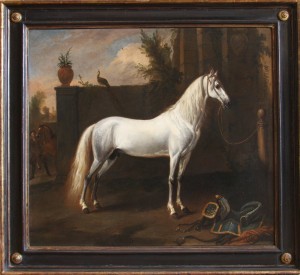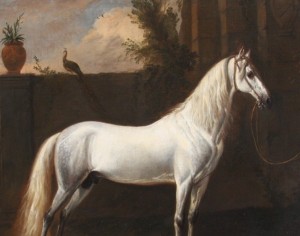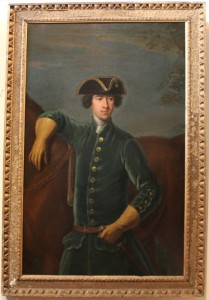YOU CAN STILL FIND A TREASURE – for Thursday is Art Day
Isn’t it exciting to think that in this crazy but wonderful world you can still find a treasure? And through the far reaching world of the Internet you can come into contact with some of the most incredibly interesting people.
The Grey Arabian by Jan Wyck – oil on canvas 40 x 50 in
One of these people would have to be Daniel Hunt from the UK. His business is Art; situated at his “Fine Art” dealings in Sloane Street London. Daniel is a man with a marvellous taste in Art, especially Equine Art. So imagine the coincidence when the latest book I’m writing delves into the art world and out of the blue I have an email about an incredible painting of early equestrian art. It seems a little surreal and very exciting to be contacted from across the world and shown such a rare and wonderful picture.
More exciting when Daniel said, “I ran into your blog which resonated with me – loved it. The growth of the internet does have some amazing benefits! I loved your blog with my “horse breeders” hat on – I’m happily obsessed with it in my small way. I bred and broke and pretrained a horse called Imperial Aviator with my kids.”
BUT even more exciting that the painting titled ‘The Grey Arabian’ by Jan Wyck is this wonderfully refined portrait of a classic Arabian horse. The work shows all the refinement of a desert bred animal as well as the large luminous eye, tiny pointed ears and the marvellous shoulders I’ve always admired in the Egyptian and Egyptian cross purebred Arabian. I could hardly wait to share the information Daniel emailed for Thursday is Art Day. If you love Arabian horse art as I do I’m sure you’ll enjoy reading the document below as much as I did. I’m also a little bit in love with The Grey Arabian by Jan Wyck and I’m sure there’s someone out there who would adore this remarkable painting for their art collection. Daniel’s details are at the end of the post. Enjoy the information …
ABOUT – The Grey Arabian by Jan Wyck (1652-1702)
This magnificent work by Jan Wyck must be regarded as one of the most significant examples of early equestrian art in England. It has an intelligence of characterisation that marks it out as being part of that true movement of English equestrian art, a movement in which the understanding of the horse becomes a fundamental part of the history of art, as it does for two and a half centuries, in a way that happens in no other country. It is also a work also entirely of its era, Baroque in its elegance and landscape, romantic in its individuality, confident in needing no squire or groom.
The painting is all the more fascinating, all the more powerful, for it being classically representative of a new Baroque portrayal of equine individuality and confidence. Before this period magnificent beasts were certainly committed to canvas, but they – like Van Dyck’s rearing and testosterone-filled chargers – were so often merely Roman animals, there to act as seating for uncertain emperors and diminutive kings. The portraits were seldom about the horses themselves.
It was partly, perhaps, the rise of sporting art at the end of the seventeenth century, combined with a more fervent pursuit of luxury and leisure – one cannot ignore the influence that Louis XIV’s court and his love of hunting must have had on the future Charles II – that allowed art to stray towards the horse as prime subject matter.
Certainly, it was also the more direct influence of Jan Wyck himself who brought the Dutch equestrian portrait genre to England. His oil studies of individual horses are perhaps his most original contribution to the history of English art. One further contribution that cannot be ignored – he taught the great John Wootton, who went on to exemplify English equestrian and military art in the 18th century.
The English equestrian portrait develops through the 18th century and early 19th century into defined sections and sub-sections, developing individual traditions – on the one hand incorporating direct and oblique strands of sporting influence (the inclusion of grooms and owners and tack), on the other, setting scenes at race courses, in stables, in pastures, or in hunt country. All the while honouring individuality and breeding, and the character of the English horse, as it evolves through diverse and developing use.
The best examples retain the direct sense of communication and character inherent and first recognisable in the Jan Wyck – and the twist of interpretation that counts as beguiling charm – as in Sawrey Gilpin’s ‘Arab Stallion Held by a Groom’. At the end of the 18th century sparser compositions develop for racecourse portraits, some of almost abstract simplicity, featuring the sides of buildings and a simple horizon as the backdrop to a horse portrait.
Each development appears to lead back to an ancestral, pure format from the end of the 17th century, a grand master, one of the great equestrian portraits by Jan Wyck. They are works of huge importance to English: in and of themselves, for their revolutionary boldness and their celebration of equestrian individuality, and also for the lineage they lay down, the blood line that courses through the history of English art for the next two hundred and fifty years.
About Jan Wyck
Jan Wyck was born in Haarlem, the son, and subsequently pupil, of the painter Thomas (van) Wyck (c.1616–1677). Wyck made his name in England as a specialist at painting horses in battle and hunting scenes, topographical and classical landscapes, and portraits of people, animals, and buildings.
His father visited Rome in the 1630s, and much of his subsequent output was of Mediterranean street or harbour scenes, though he also painted Dutch domestic interiors and alchemists’ laboratories. He married in Haarlem on 22 May 1644, and came to England c.1664 where he drew and painted views of London, and night scenes of the great fire. Father and son were established in London in this decade, and on 17 June 1674 Jan promised to present his ‘proofe peece’, and pay his own and his father’s quarterly fees to the Painter–Stainers’ Company in the City of London. On 24 November 1680 he was placed upon ‘The Committee of Acting Painters’ of the company to represent working painters as distinct from the decorators and interior designers. Thomas soon returned to Haarlem where he died and was buried on 19 August 1677.
Jan Wyck married three times and had seven children by his second and third wives, though the four by his second wife all died young. Wyck himself died on 26 October 1700 in Mortlake to where he had removed from Covent Garden after the death of his second wife in 1687.
Wyck was a relatively prolific artist, and numerous works by his survive. His portrayals of equestrian subjects, which included battle scenes in the style of Wouvermans, hunting scenes (of which genre he was a pioneer in England) and topographical views of country houses and estates were widely collected by patrons in the highest strata of society. He must have been widely itinerant, since his topographical paintings depict places as far afield as Windsor, Dunham Massey in Cheshire, Sprotborough Hall in Yorkshire and the new docks at Whitehaven.
He was also an extraordinary pioneer of the equestrian portrait in England. It was, perhaps, inevitable that this sort of subject-matter would have endeared him to his generally grand clientele, since his arrival in England coincided with a boom in the arts at the Restoration after the visually-deprived years of the Commonwealth.
Wyck seems to have enjoyed Court Patronage from fairly soon after his arrival in England: a Battle Piece is recorded in the royal inventories taken at the time of the Glorious Revolution of 1688 and he is presumably to be identified with the ‘Jan van Wijck’ who was taken to Holland in 1682 to ‘help … find out horses’ for Queen Catherine, wife of Charles II. Wyck’s drawings of country pursuits appeared as engravings in Richard Blome’s The Gentleman’s Recreation (1686). Two of these drawings for the latter are in the British Museum, along with his drawing of The Thames During the Great Frost of 1683/4.
His work is represented in numerous Museums and old country house collections in the UK; his pupil John Wootton continued his master’s style well into the 18th century. He died on 26 October 1700 in Mortlake.
Daniel Hunt, Fine Art 60 Lower Sloane Street London SW1W 8BP
Tel: 0207 259 0304 Mob: 07798 625545 email: daniel-hunt@btconnect.com



Leave a Reply